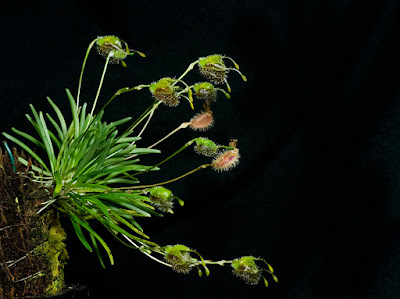Diodonopsis erinacea is found in Costa Rica, Panama, Colombia and Ecuador. They grows as an epiphyte in premontane rain forests at altitudes of 700 to 1400 meters...
Diodonopsis erinacea also called as The Hedgehog Diodonopsis, Masdevallia erinacea, Masdevallia echinocarpa, Masdevallia horrida, Scaphosepalum erinaceum, is a species of the genus Diodonopsis. This species was described by Pridgeon & M.W.Chase in 2001.
IDENTIFY DIODONOPSIS ERINACEA
Diodonopsis erinacea is found in Costa Rica, Panama, Colombia and Ecuador. They grows as an epiphyte in premontane rain forests at altitudes of 700 to 1400 meters.
It is a warm to cool growing epiphyte with erect stems covered with tubular bracts and a single, apical subcoriaceous, linear-lanceolate, 4 cm long leaf.
The Hedgehog Diodonopsis has single flowered, 4 to 7 cm long inflorescence occuring in the summer with the flowers held just above the leaves. The 1.5 cm in diameter flowers are bristly, like a hedgehog, which is the Latin derivation for the species epithet, although some growers think the flower looks more like a space alien. It has a yellow dorsal sepal with reddish brown lateral sepals, all with downward-pointing tails.
DIODONOPSIS ERINACEA CARE AND CULTURE
Cultural information should only be used as a guide, and should be to be adapted to suit you. Your physical location; where you grow your plants, how much time you have to devote to their care, and many other factors, will need to be taken into account. Only then can you decide on the cultural methods that best suit you and your plants.
Light:
Diodonopsis erinacea needs a light level of 8000-12000 lux, the photoperiod of 11-12 hours a day. It must never be exposed to direct sunlight, light must be filtered.
Temperature:
The maximum daytime temperatures are 24-26 ° C during the day all year round; minimum night temperatures are 12-13 ° C all year round. Let's remember to ensure the presence of sudden changes of 9-11 ° C between day and night, which are vital for the harmonious development and for the flowering of the orchid.
Humidity:
The Hedgehog Diodonopsis needs the humidity which must never fall below 65%. 70-75% must be achieved in the ideal.
Substrate, growing media and repotting:
Diodonopsis erinacea can be grow both in pots and cultivated with bare roots on a raft. Whichever way we choose, it is always necessary to remember that this species loves humidity, so the substrate must satisfy this need. We grow it only in sphagnum mixed with perlite (2: 1 or 1: 1), using a transparent plastic pot or a basket. If we choose a raft, it is necessary to put different layers of the sphagnum between the raft and the roots of the plant.
Watering:
Its development does not include any rest period, so this species is regularly bathed throughout the year, as soon as the substratum has dried out quite well (but before it becomes completely dry).
Fertilizer:
This orchid is fertilized every 3-4 watering with 1/4 of the dose indicated on the vial of a special liquid fertilizer for orchids. If it is placed bare-root, 1/10 of the spray water dose is added every 7-10 days.
Rest period:
Diodonopsis erinacea does not need a rest period. After the flowering period, in autumn, it is recommended to transfer the plant by replacing the old substrate with the new one, cutting away the dead roots and taking care not to damage the healthy ones.















COMMENTS